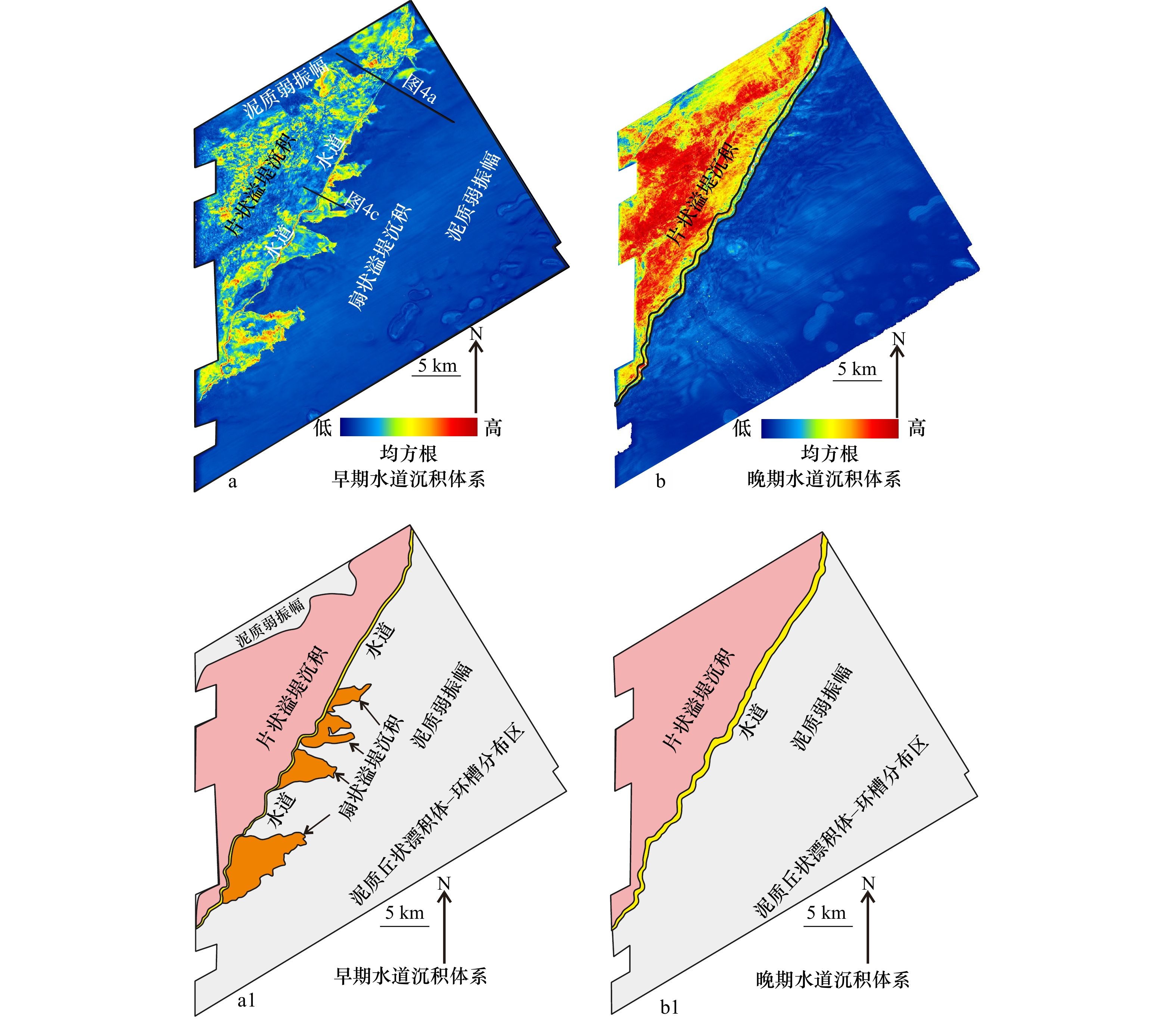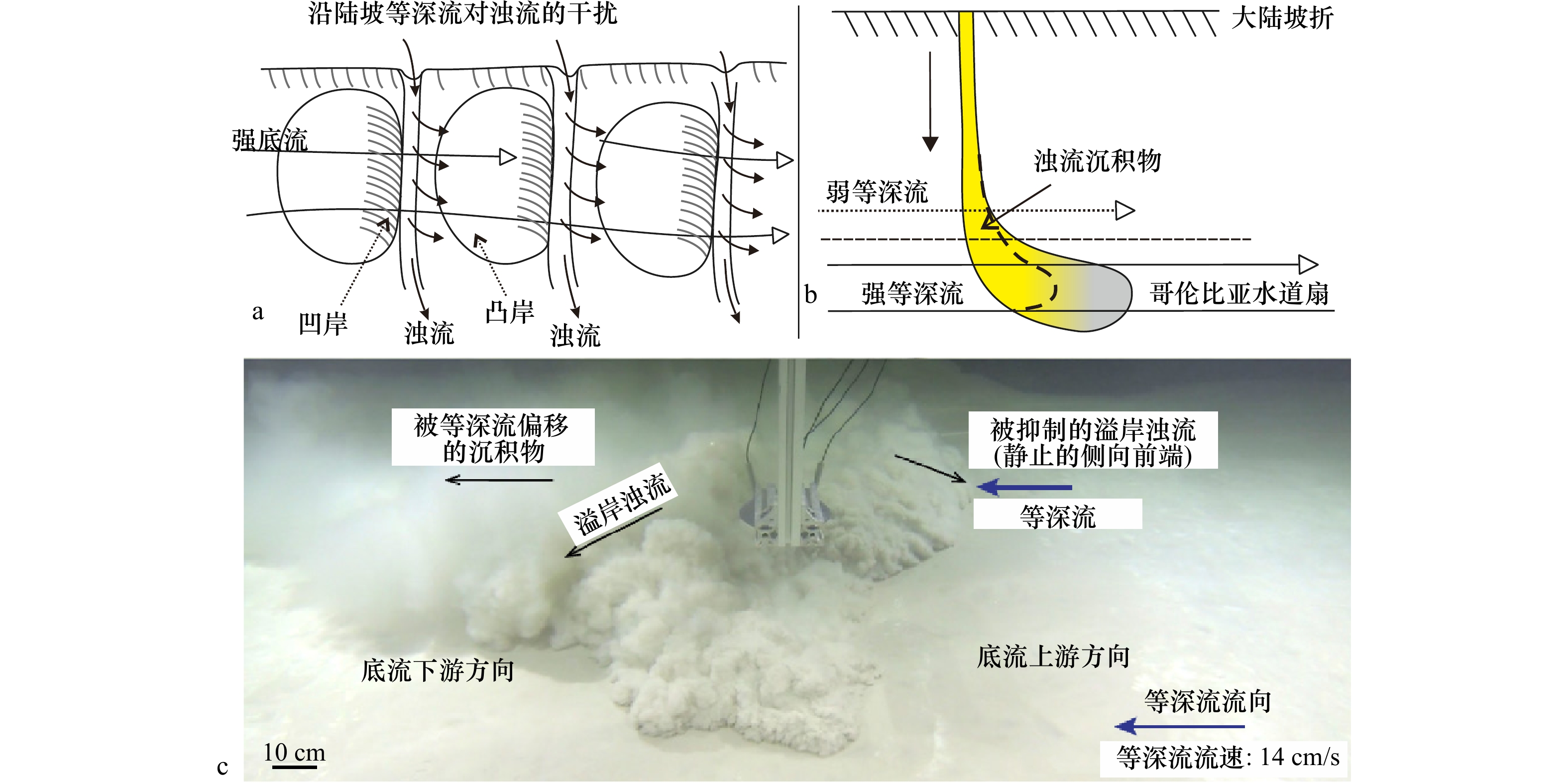Pliocene channel sedimentary system influenced by contour currents in the Beijiao Sag, Qiongdongnan Basin
-
摘要: 等深流影响的水道沉积体系的沉积特征及其沉积过程是当前深水沉积学研究的热点、难点和前沿科学问题,但研究程度较为薄弱。该文以北礁凹陷上新统(地震反射T20−T30)为研究对象,利用覆盖北礁凹陷局部的三维地震资料,采用均方根属性、相干属性、时间域构造,再结合地震切片等方法,研究北礁凹陷深水区上新统斜交斜坡(走向)的特殊水道沉积体系特征及其沉积过程。研究发现,该水道沉积体系分为早、晚两期,早期发育水道和片状、扇状溢堤沉积,晚期仅发育水道和片状溢堤沉积,其中扇状溢堤沉积仅发育在水道右侧弯曲处,片状溢堤沉积仅分布在水道左侧,水道始终与区域斜坡斜交,水道对称分布且无明显迁移现象。结合该时期北礁凸起发育等深流相关的丘状漂积体和环槽,认为该水道沉积体系特殊的形态主要受控于等深流与浊流交互作用的沉积结果:浊流流经水道,其上覆浊流溢出水道,形成溢岸浊流,在水道左侧,该溢岸浊流与等深流发生相向运动,被等深流“吹拂”到单侧,大面积分布,延伸千米,形成片状溢堤沉积;而在水道弯曲处(右侧),溢岸浊流与等深流发生相对运动,抑制溢岸浊流进一步扩展,形成相对小范围扇状溢堤沉积,该沉积结果与前人水槽实验结果相一致。Abstract: Depositional characteristics and process of deep-water channel sedimentary system influenced by contour currents is a current hotspot and new scientific issue in the study of deposits resulted from interaction between contour currents and turbidity flows. Using root mean square (RMS) attribute, coherenceseismic attribute, time structure and stratal slice, we focus on depositional characteristics and process of the channel sedimentary system in Pliocene strata in the Beijiao Sag, Qiongdongnan Basin. The results show that the channel sedimentary systems are divided into the early and late channel sedimentary systems. The depositonal units of the early system include channel, flake-shaped and fan-shaped overbank deposits. The units of the late systems incorporate: channel and flank-shaped overbank deposits. Fan-shaped overbank deposits are only distributed on the right side of the bend of the channel. Flake-shaped overbank deposits are only located on the left side of the channel. The channels are persistently oblique to the strike of the slope and they are symmetrical and characterized by vertical aggradations. Combined with the development features of mounded drifts and moats over the Beijiao uplift, it is inferred that the geometry of the channel sedimentary systems are mainly controlled by depositional products of the interaction between turbidity flows and contour currents. Contour currents flow across channels, forcing the upper part (low velocity and low density) of turbidity flows to deflect towards the left (downstream) side of channels and then form overspill currents. The direction of overspills is the same to that of contour currents, in this case, generating wide flake-shaped overbank deposits extending for several kmlometers. In the bend of channels, the direction of overspill currents is in contrast to that of contour currents, blocking or confining the range of the overbank deposits and then creating fan-shaped overbank deposits. This result are consistent with the previous results of flume-tank experiment.
-
Key words:
- Bejiao Sag /
- channel sedimentary system /
- overbank deposits /
- contour currents /
- turbidity flows
-
图 1 等深流与浊流交互作用的两种沉积类型
a. 向等深流下游方向单向迁移的水道沉积体系模式(引自文献[3]);b. 向等深流上游方向单向迁移的水道沉积体系模式(改自文献[16-18])
Fig. 1 Two types of sediment models for the interaction between contour currents and turbidity flows
a. Channel sedimentary system model for unidirectional downstream migrating of contour current flows (cited from reference [3]); b: channel sedimentary system for unidirectional upstream migrating of contour current flows (modified from references [16-18])
图 3 琼东南盆地深水区地层综合柱状图
此图展示了沉积相(引自文献[29])、构造运动及演化(引自文献[24])、强振幅水道发育/分布层位(引自文献[15])及海平面变化(引自文献[27])
Fig. 3 Comprehensive stratigraphic histogram in the deep-water area of the Qiongdongnan Basin
It shows characteristics of sedimentary facies (cited from reference [29]), tectonic movement and evolution (cited from reference [24]), development or distribution location of channels with high amplitudes (cited from reference [15]), and eustatic sea level change (cited from reference [27])
图 4 琼东南盆地北礁凹陷上上新统早−晚期水道沉积体系剖面特征(a−c)及其沉积单元划分(b1,c1)
绿色实线“S”为早晚期水道沉积体系分界线
Fig. 4 Profiles characteristics (a−c) and sediment units divisions (b1, c1) of the early and late channel sedimentary systems in the upper Pliocene in the Beijiao Sag, Qiongdongnan Basin
Solid green line “S” presenting the boundary between early and late channel sedimentary systems
图 5 琼东南盆地北礁凹陷上新统早−晚期水道沉积体系均方根属性(a,b)及其沉积相解释(a1,b1)
a. 时窗为分界面S至S下移(+)40 ms;b. 时窗为分界面S至S上移(−)40 ms
Fig. 5 RMS attributes (a, b) and their sedimentary facies interpretation (a1, b1) of the early and late channel sedimentary systems in the Pliocene in the Beijiao Sag, Qiongdongnan Basin
a. Time window from boundary “S” to the downward shift (+) 40 ms of “S”; b. time window from boundary “S” to the upward shift (−) 40 ms of “S”
图 7 等深流与浊流交互作用下浊流溢出堤岸的沉积模式及其水槽实验
a. 沿斜坡等深流与跨斜坡浊流的交互作用平面形态(引自文献[8]);b. 由于浊流受到等深流的影响发生溢岸浊流,致哥伦比亚水道(扇)末端朵叶体向等深流下游方向迁移(引自文献[8]);c. 等深流与浊流交互作用的水槽实验(引自文献[34])
Fig. 7 Sedimentary models and flume-tank experiment of turbidity flows overflowing levees under the interaction of contour currents and turbidity flows
a. Interaction planform morphology of along-slope contour currents and across-slope turbidity flows (cited from reference [8]); b. lobe at the end of Columbia channel (fan) migrating downstream of contour currents, due to overspills from turbidity flows affected by contour currents (cited from reference [8]); c. flume-tank experiment of the interaction between contour currents and turbidity flows (cited from reference [34])
-
[1] Zhu Mangzheng, Graham S, Pang Xiong, et al. Characteristics of migrating submarine canyons from the middle Miocene to present: implications for paleoceanographic circulation, northern South China Sea[J]. Marine and Petroleum Geology, 2010, 27(1): 307−319. doi: 10.1016/j.marpetgeo.2009.05.005 [2] Li Hua, Wang Yingmin, Zhu Weilin, et al. Seismic characteristics and processes of the Plio-Quaternary unidirectionally migrating channels and contourites in the northern slope of the South China Sea[J]. Marine and Petroleum Geology, 2013, 43: 370−380. doi: 10.1016/j.marpetgeo.2012.12.010 [3] Gong C L, Wang Yingmin, Steel R J, et al. Flow processes and sedimentation in unidirectionally migrating deep-water channels: from a three-dimensional seismic perspective[J]. Sedimentology, 2016, 63(3): 645−661. doi: 10.1111/sed.12233 [4] Zhou Wei, Wang Yingmin, Gao Xianzhi, et al. Architecture, evolution history and controlling factors of the Baiyun submarine canyon system from the middle Miocene to Quaternary in the Pearl River Mouth Basin, northern South China Sea[J]. Marine and Petroleum Geology, 2015, 67: 389−407. doi: 10.1016/j.marpetgeo.2015.05.015 [5] He Yunlong, Xie Xinong, Kneller B C, et al. Architecture and controlling factors of canyon fills on the shelf margin in the Qiongdongnan Basin, northern South China Sea[J]. Marine and Petroleum Geology, 2013, 41: 264−276. doi: 10.1016/j.marpetgeo.2012.03.002 [6] 李俞锋, 蒲仁海, 张功成. 琼东南盆地晚中新世以来底流流向及沉积侵蚀特征[J]. 地球物理学进展, 2018, 33(6): 2546−2554Li Yufeng, Pu Renhai, Zhang Gongcheng. Direction and deposition/erosion characteristics of the bottom currents in the QDNB, northwestern South China Sea[J]. Progress in Geophysics, 33(6): 2546−2554. [7] Viana A R, Almeida J W, Machado L C. Different styles of canyon infill related to gravity and bottom current processes: examples from the upper slope of the Se Brazilian margin[C]//Proceeding of 6th International Congress of the Brazilian Geophysical Society, Netherlands: European Association of Geoscientists & Engineers, 1999: 14−18. [8] Faugères J C, Stow D A V, Imbert P, et al. Seismic features diagnostic of contourite drifts[J]. Marine Geology, 1999, 162(1): 1−38. doi: 10.1016/S0025-3227(99)00068-7 [9] Rasmussen S, Lykke-Andersen H, Kuijpers A, et al. Post-Miocene sedimentation at the continental rise of Southeast Greenland: the interplay between turbidity and contour currents[J]. Marine Geology, 2003, 196(1/2): 37−52. [10] Biscara L, Mulder T, Gonthier E, et al. Migrating submarine furrows on Gabonese margin (West Africa) from Miocene to present: influence of bottom current?[C]//Proceeding of Deep-Water Circulation: Processes & Products. Pontevedra, Spain: International Congress, 2010: 21−22. [11] Gong Chenglin, Wang Yingmin, Zheng Rongcai, et al. Middle Miocene reworked turbidites in the Baiyun Sag of the Pearl River Mouth Basin, northern South China Sea margin: processes, genesis, and implications[J]. Journal of Asian Earth Sciences, 2016, 128: 116−129. doi: 10.1016/j.jseaes.2016.06.025 [12] Gong Chenglin, Wang Yingmin, Rebesco M, et al. How do turbidity flows interact with contour currents in unidirectionally migrating deep-water channels?[J]. Geology, 2018, 46(6): 551−554. doi: 10.1130/G40204.1 [13] 孙辉, 吕福亮, 范国章, 等. 三级层序内受底流影响的富砂深水沉积演化规律−以东非鲁武马盆地中中新统为例[J]. 天然气地球科学, 2017, 28(1): 106−115.Sun Hui, Lü Fuliang, Fan Guozhang, et al. Evolution of deepwater sand-rich sediments affected by bottom currents in the RD order sequences: a case study of Middle Miocene in the Ruvuma Basin[J]. Natural Gas Geoscience, 2017, 28(1): 106−115. [14] 陈宇航, 姚根顺, 吕福亮, 等. 东非鲁伍马盆地渐新统深水水道−朵体沉积特征及控制因素[J]. 石油学报, 2017, 38(9): 1047−1058. doi: 10.7623/syxb201709006Chen Yuhang, Yao Genshun, Lü Fuliang, et al. Sedimentary characteristics and controlling factors of Oligocene deep-water channel-lobe in Rovuma Basin of the East Africa[J]. Acta Petrolei Sinica, 2017, 38(9): 1047−1058. doi: 10.7623/syxb201709006 [15] 李俞锋. 琼东南盆地北礁凹陷梅山组单向迁移水道特征及成因探讨[J]. 海洋学报, 2019, 41(1): 72−86.Li Yufeng. The characteristics and origin of unidirectionally migrating channels of Meishan Formation in the Beijiao Sag, Qiongdongnan Basin[J]. Haiyang Xuebao, 2019, 41(1): 72−86. [16] Fonnesu F. The Mamba complex supergiant gas discovery (Mozambique): an example of turbidite fans modified by deep-water tractive bottom currents[C]//Proceedings of the 12th PESGB/HGS Conference on African E&P. London: PESGB Conferences Ltd., 2013. [17] Fonnesu M, Palermo D, Galbiati M, et al. A new world-class deep-water play-type, deposited by the syndepositional interaction of turbidity flows and bottom currents: the giant Eocene Coral Field in northern Mozambique[J]. Marine and Petroleum Geology, 2020, 111: 179−201. doi: 10.1016/j.marpetgeo.2019.07.047 [18] Lu Yintao, Luan Xiwu, Shi Boqing, et al. Migrated hybrid turbidite-contourite channel-lobe complex of the late Eocene Rovuma Basin, East Africa[J]. Acta Oceanologica Sinica, 2021, 40(2): 81−94-1. doi: 10.1007/s13131-021-1750-1 [19] Chen Yuhang, Yao Genshun, Wang Xiaofeng, et al. Flow processes of the interaction between turbidity flows and bottom currents in sinuous unidirectionally migrating channels: an example from the Oligocene channels in the Rovuma Basin, offshore Mozambique[J]. Sedimentary Geology, 2020, 404: 105680. doi: 10.1016/j.sedgeo.2020.105680 [20] 李华, 何幼斌. 鄂尔多斯盆地西南缘奥陶系平凉组改造砂沉积特征及意义[J]. 石油与天然气地质, 2018, 39(2): 384−397. doi: 10.11743/ogg20180217Li Hua, He Youbin. Sedimentary characteristics and significance of reworked sands in the Ordovician Pingliang Formation, southwestern margin of Ordos Basin[J]. Oil & Gas Geology, 2018, 39(2): 384−397. doi: 10.11743/ogg20180217 [21] Gong Chenglin, Wang Yingmin, Zhu Weilin, et al. Upper Miocene to Quaternary unidirectionally migrating deep-water channels in the Pearl River Mouth Basin, northern South China Sea[J]. AAPG Bulletin, 2013, 97(2): 285−308. doi: 10.1306/07121211159 [22] Shanmugam G. Contourites: physical oceanography, process sedimentology, and petroleum geology[J]. Petroleum Exploration and Development, 2017, 44(2): 183−216. doi: 10.1016/S1876-3804(17)30023-X [23] Ru K, Pigott J D. Episodic rifting and subsidence in the South China Sea[J]. AAPG Bulletin, 1986, 70(9): 1136−1155. [24] 张功成, 张义娜, 沈怀磊, 等. “源热共控”琼东南盆地的天然气勘探潜力[J]. 天然气工业, 2014, 34(7): 18−27. doi: 10.1016/j.marpetgeo.2006.03.004Zhang Gongcheng, Zhang Yi’na, Shen Huailei, et al. An analysis of natural gas exploration potential in the Qiongdongnan Basin by use of the theory of joint control of source rock and geothermal heat[J]. Natural Gas Industry, 2014, 34(7): 18−27. doi: 10.1016/j.marpetgeo.2006.03.004 [25] 李俞锋, 蒲仁海, 樊笑微, 等. 琼东南盆地北礁凹陷多边形断层发育特征及成因[J]. 大地构造与成矿学, 2017, 41(5): 817−828.Li Yufeng, Pu Renhai, Fan Xiaowei, et al. Characteristics and genesis of the polygonal fault system in Beijiao Sag of the Qiongdongnan Basin, the northern South China Sea[J]. Geotectonica et Metallogenia, 2017, 41(5): 817−828. [26] 李俞锋, 蒲仁海, 屈红军, 等. 琼东南盆地北礁凹陷梅山组顶部丘形反射特征及成因分析[J]. 海洋学报, 2017, 39(5): 89−102.Li Yufeng, Pu Renhai, Qu Hongjun, et al. The characteristics and genesis analysis of the mound at the top of Meishan Formation in the Beijiao Sag of the Qiongdongnan Basin[J]. Haiyang Xuebao, 2017, 39(5): 89−102. [27] 魏魁生, 崔旱云, 叶淑芬, 等. 琼东南盆地高精度层序地层学研究[J]. 地球科学——中国地质大学学报, 2001, 26(1): 59−66.Wei Kuisheng, Cui Hanyun, Ye Shufen, et al. High-precision sequence stratigraphy in Qiongdongnan Basin[J]. Earth Science—Journal of China University of Geosciences, 2001, 26(1): 59−66. [28] Wyrtki K. Physical oceanography of the Southeast Asian water[C]//NAGA Report Vol 2, Scientific Results of Marine Investigations of the South China Sea and the Gulf of Thailand 1959−1961. La Jolla, California: Scripps Institution of Oceanography, 1961: 1−195. [29] Tian Jie, Wu Shiguo, Lü Fuliang, et al. Middle Miocene mound-shaped sediment packages on the slope of the Xisha carbonate platforms, South China Sea: combined result of gravity flow and bottom current[J]. Deep-Sea Research Part II: Topical Studies in Oceanography, 2015, 122: 172−184. doi: 10.1016/j.dsr2.2015.06.016 [30] Chen Hui, Xie Xinong, Van Rooij D, et al. Depositional characteristics and processes of alongslope currents related to a seamount on the northwestern margin of the Northwest Sub-Basin, South China Sea[J]. Marine Geology, 2014, 355: 36−53. doi: 10.1016/j.margeo.2014.05.008 [31] 肖彬. 深水水道沉积体系及成因机制研究[D]. 荆州: 长江大学, 2014Xiao Bin. Sedimentary system and formation mechanism of deep-water channel complex[D]. Jingzhou: Yangtze University, 2014. [32] Sun Qiliang, Cartwright J, Wu Shiguo, et al. Submarine erosional troughs in the northern South China Sea: evidence for Early Miocene deepwater circulation and paleoceanographic change[J]. Marine and Petroleum Geology, 2016, 77: 75−91. doi: 10.1016/j.marpetgeo.2016.06.005 [33] 李俞锋, 蒲仁海, 牛宁, 等. 谷−丘互相对称的地震反射特征与成因及对琼东南盆地北礁凹陷的意义[J]. 地质科技情报, 2017, 36(3): 286−292.Li Yufeng, Pu Renhai, Niu Ning, et al. Genesis and characteristics of the mutually symmetric trough-mound/hummock seismic reflections and their geological significance in Beijiao Sag, Qiongdongnan Basin[J]. Geological Science and Technology Information, 2017, 36(3): 286−292. [34] Miramontes E, Eggenhuisen J T, Jacinto R S, et al. Channel-levee evolution in combined contour current–turbidity current flows from flume-tank experiments[J]. Geology, 2020, 48(4): 353−357. doi: 10.1130/G47111.1 -





 下载:
下载:







